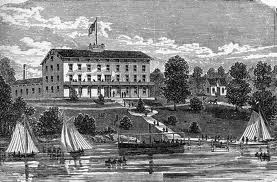 |
| Olin |
As a blank slate "paper town," there were many forces in the early years of Madison's formation that could have taken over and become the city's signature approach to development. Before the turn of the 20th century and not far beyond, there were two chief competing interests vying for power in frontier cities: factory and manufacturing on one hand, and beautification on the other. Chicago might well be considered a city that moved in the direction of factories and manufacturing. Madison, though,
 |
| John Olin |
through the leadership and insight of a few early settlement visionaries, became a city devoted to its natural resources, parks and "pleasure drives." If Doty began it all as a visionary founder who would 'plat' an entire city from nothing but raw land and water, it was John Olin who took that plat and promoted early direction for development. Olin has been deemed a "citizen extraordinaire," not so much because of his personal demeanor (he was cold, austere, and extremely direct with words), but because he devoted the better part of two decades promoting to a community of leaders the absolute need to cherish and uphold the dignity of Madison's natural surroundings. He somewhat famously remarked that he saw that his job was the "creation of an intelligent public sentiment and the promotion of correct opinions." Besides being an outstanding professor and lawyer, Olin was president and the driving force behind the Madison Park and Pleasure Drive Association. "When he began, the city had fewer than four acres of public parks, but when he turned the reins over to others in 1909 the city had 269 acres of parkland and had raised more than $250,000 in donations for the
acquisition, development, and maintenance of parks...he did most of this fund raising by sending out penny postcards to association members, reminding them to send in their annual five-dollar contributions. Nearly one in ten Madison households belonged to the organization." Olin created a very focused two-prong initiative to maintain and showcase Madison natural resources; he lifted up the sentiment and civic responsibility of the common man, but he also "persuaded city leaders that Madison required a comprehensive city plan at a time when few had even hear of urban planning." It was Oin who made the imaginative arrangements to seek out one of, if not the, greatest urban planners of the day, John Nolen.
As a modern observer looks back at these two extraordinary leaders (Doty and Olin, soon to come Nolen), we can begin to understand the sort of roots of civic responsibility that is the true cornerstone of Madison city culture. A sort of early consciousness of one's place within geography and nature was established. Despite an understandably tremendous pull toward increased black smoke from factory smoke stacks – there was a very strong
 |
| Yahara River and bridge, east Madison, an original project initiated by Olin |
tendency during this time to equate the smell of black of smoke with good pure progress – Madison held out and did not give in to the sometimes false logic. Olin and other leaders embraced the expertise and leadership of early UW professors and put it to real use. City planning was not merely an act of bureaucratic city officials, but a combined effort between an educated public, visionary leaders, and professorial expertise. This would come to be known as the "Wisconsin Idea," a hopeful integration of talents from every level of society.












































